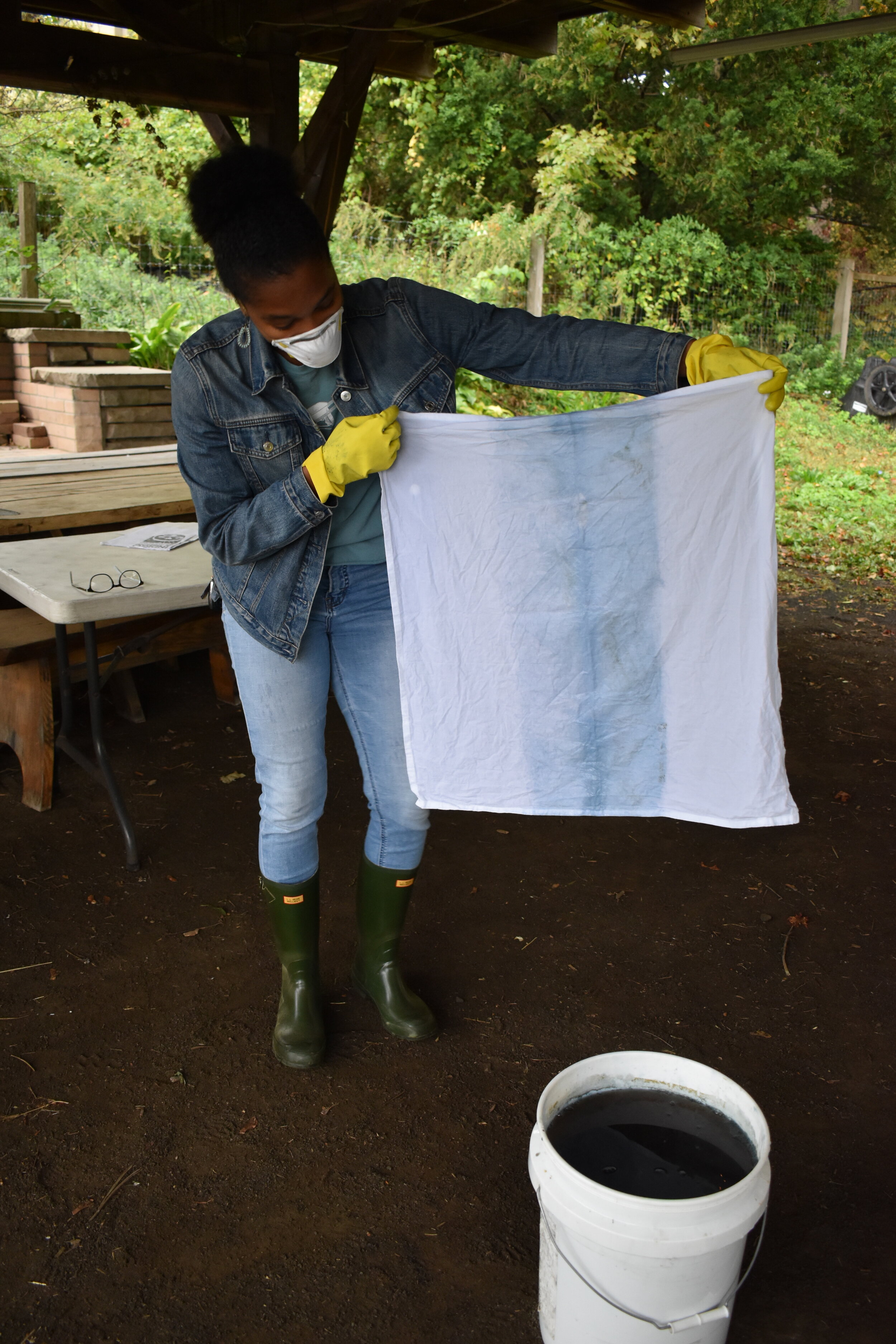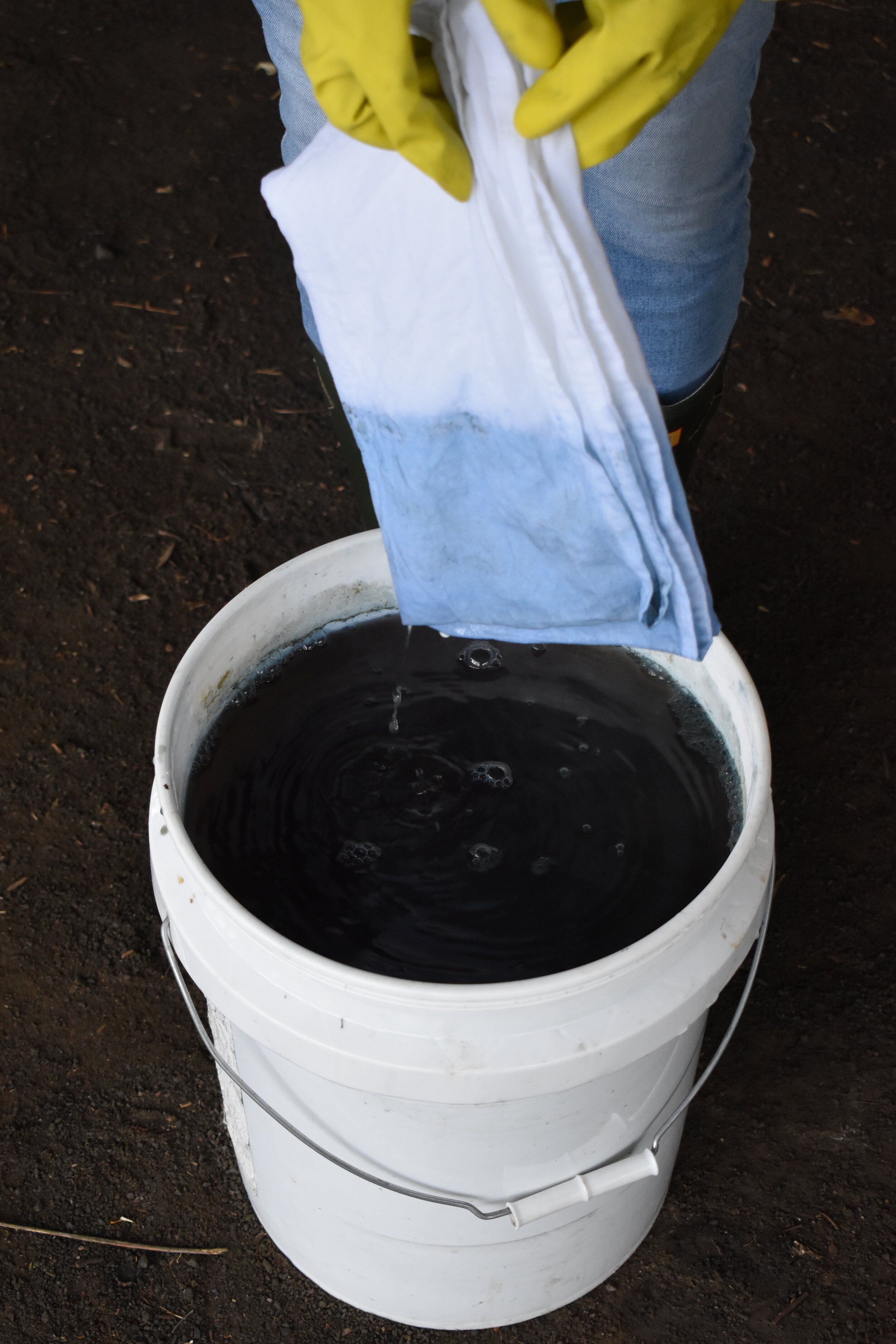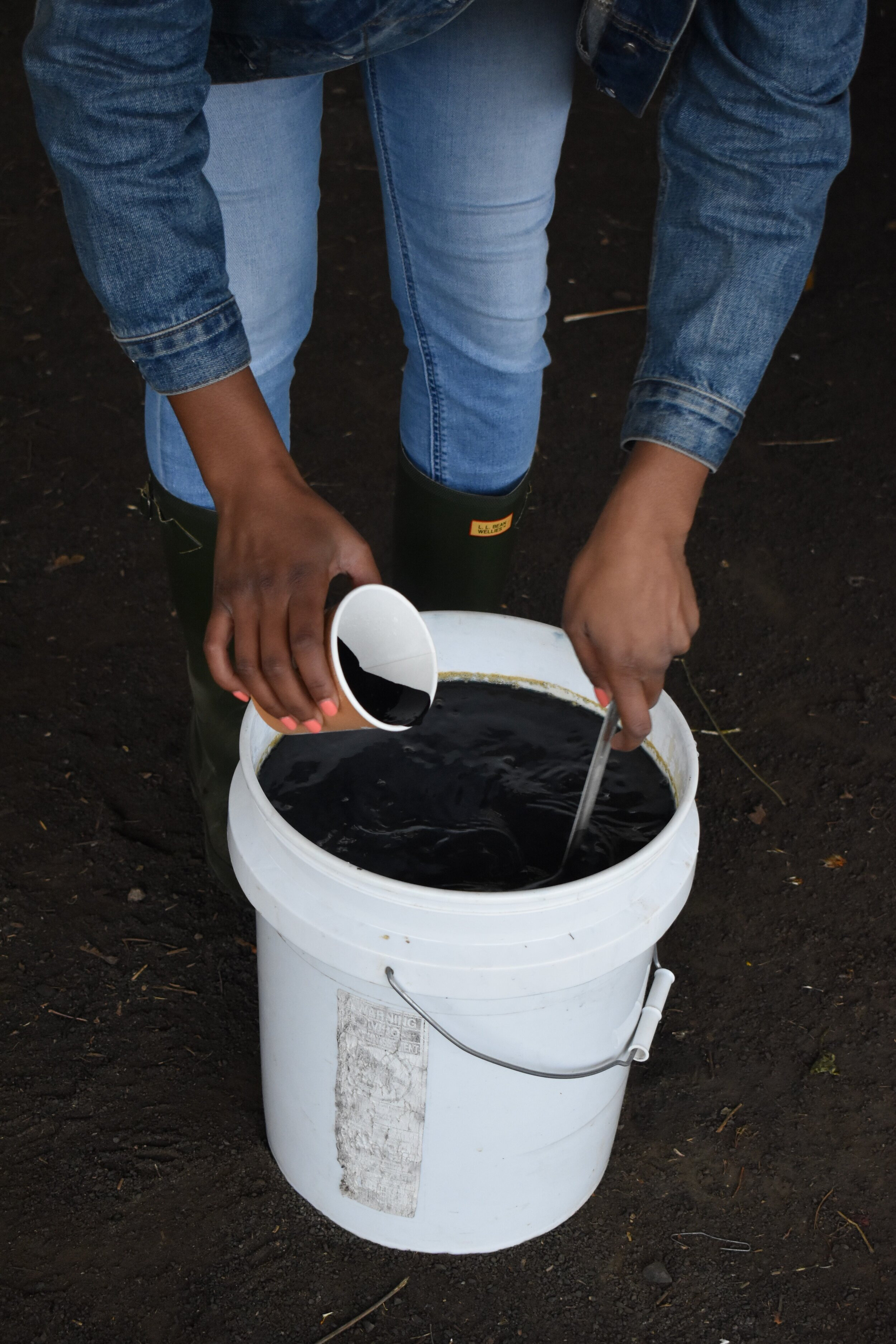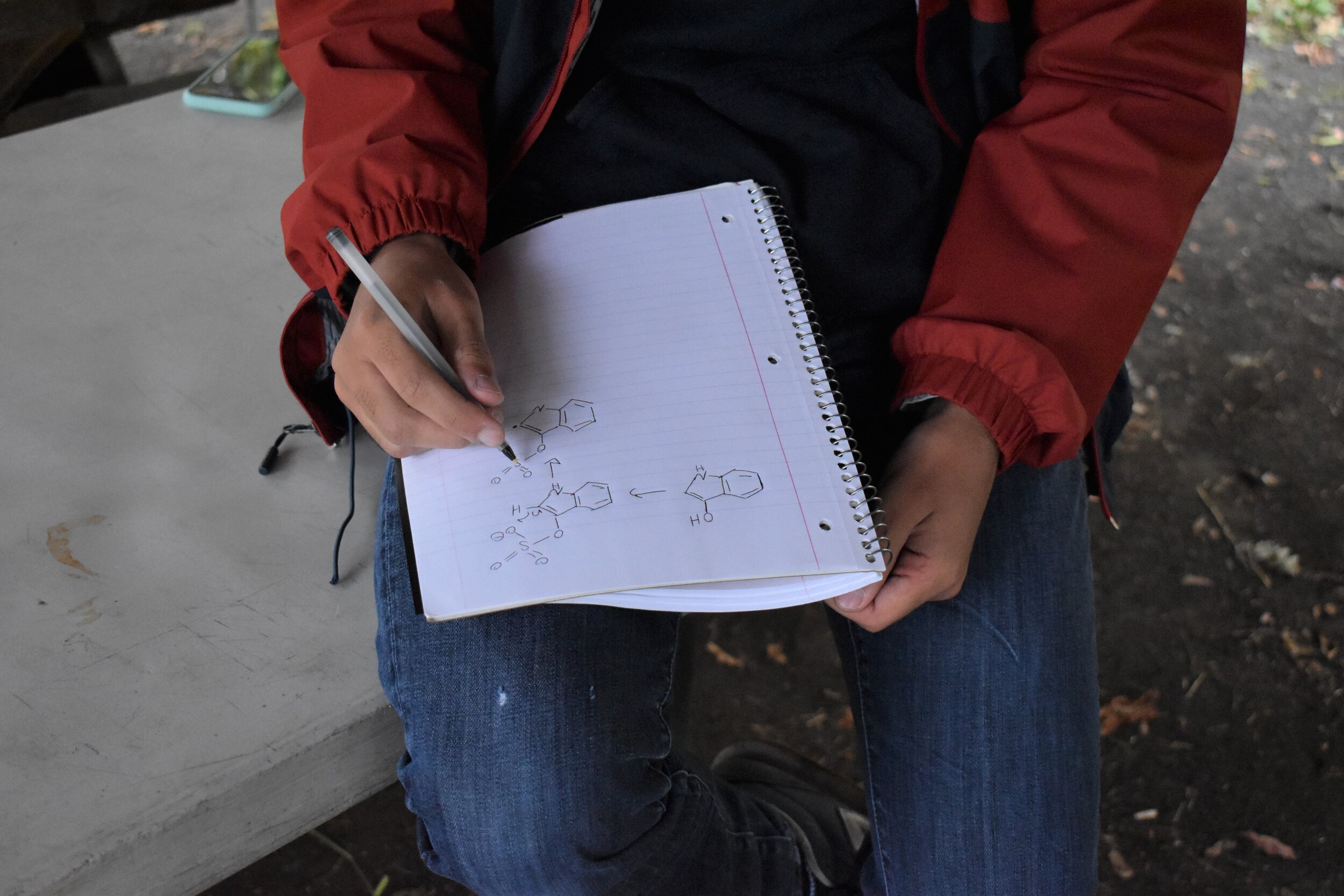
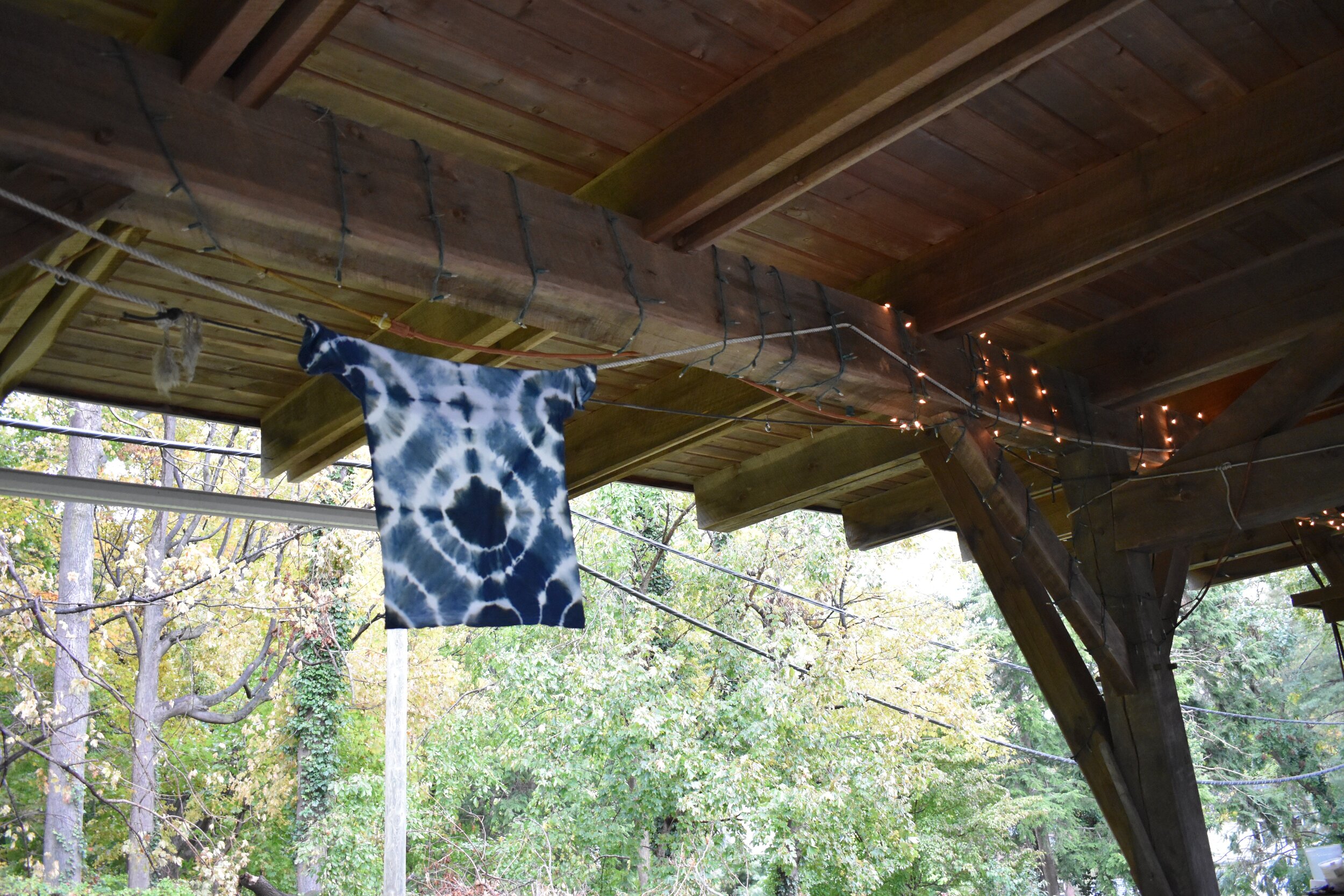
Deja Chappell ’21 has worked with the YSFP as a Market Manager and as a Seed-to-Salad Coordinator. This year, she leads the natural dye workshops for YSFP students, and participates in farm workdays. She is currently pursuing her B.A. in Ethnicity, Race, and Migration.
Camden Smithtro ’22 is part of the YSFP’s communications team. She is an Environmental Studies major, with a concentration in Food and Agriculture. The best part of her job is learning from her fellow YSFP staff members!
Camden Smithtro: How did you begin dyeing with indigo?
Deja Chappell: I got involved with natural dyeing really randomly, just being on Instagram and looking at people do natural dyeing or mending, and fashion sewing. Pretty much anything with textiles. I was like, ‘oh, this is really cool!’
Before this I’d been introduced to the idea of eco-fashion, which was presented as ‘you better make really good individual choices. And you better, you know, only buy really expensive ethical brands.’ But then looking into it more, and also finding more people of color in that section of Instagram, I realized that eco-fashion was bigger than just your individual decisions.
There's a whole global fast-fashion industry that's built on exploitation and unsound ecological practices. So I sort of saw natural dyes as a way to counter that. Yeah, it's really tactile, and it's really cool. And yeah, it was this aesthetic preference, but it was also this political decision as well.
I started following this one particular dyer, Graham Keegan. And he was doing a national tour, basically a cross-country dye workshop tour. I saw there was one in Alabama last summer, right before I was about to go out of the country. And so I was like, ‘what if I signed up and just went to do it? Otherwise I wouldn't know how to [dye with natural indigo].’ And then I went to that workshop, and that was a really wonderful experience. I met a chef there who had been involved in the YSFP in the early days, and knew Alice Waters. It was in the middle of nowhere, at an Antebellum mansion near Selma in a place called Marion, Alabama. It was a very interesting experience. I learned a lot and that's when I realized after you process all the indigo, and after you make the vat setup, there is so much room to be creative.
And of course, I'm still learning more. I'm from the Southeast, and am the descendant of enslaved people. I thought about exploitative mono-cropping and enslaved labor in the Southeast and how we always hear that they were growing cotton. When I researched more, I realized they were also growing indigo, because indigo grows really well in humid climates. And I realized not only is this [Southern land] unceded stolen territory that's being exploited, with its soils being diminished and ruined from the plantation economy, but this exploitation was also tied to the global textile market. And to this day, I feel like there's a connection between racial capitalism and the fast fashion industry, especially all of the waste and environmental destruction from fast fashion today. So I feel connected to natural dying in a political sense. Even if it's just an interest, it still has these political implications.
CS: So you follow these people on Instagram, then you went to the workshop. Was the next step talking to Jeremy and bringing the indigo to the farm? Or was there also an in-between?
DC: Oh, yes! So the way that the Yale Farm started to grow indigo began with the all-staff meeting in spring 2019. I had already been working for the Farm coordinating with public schools for Seed to Salad. And then we had the all-staff meeting and Marisa talked about growing mushrooms, and Jeremy made a point that the Farm is a place where we want to support everyone’s curiosity. And we will also pay [for students] to do cool things. So, at the end of that meeting, I just went up to Jeremy and I was like, would we ever grow indigo? And Jeremy told me ‘yes, the Farm is focused on food, fiber, and fuel. So that would fall into the fiber category. And that is absolutely something we'd be interested in doing.’
And then I told Jacquie, and Jacquie told me that someone had tried to do, you know, indigo and natural dyes before and it just sort of faded out, but the Farm would love to do it again. So it's actually not even me that started it. Many people before me have been interested. But it really was just that simple conversation.
The next thing I knew, Jeremy is telling me that he’s going to be planting indigo for the summer [of 2019]. So then when I came back to school that fall, we had this little test plot of indigo.
CS: Yeah, I was a Lazarus Summer Intern that summer. I remember seeing the baby indigo!
DC: And I'll just go ahead and say that last year, when I tried to process the plants that was my first time ever doing that, it failed. I let them soak too long. And then I also did that again this year. But the encouragement from Jeremy and Jacquie and everybody has been: it's okay to fail here. This didn't work out this year, and we'll do it again next year. We'll try again, and we'll learn. I still wish we could dye with our own indigo. But I feel like next year, we will know exactly what to do.
CS: Can you walk me through how you get from plant to pigment?
DC: Yes. But first I want to — part of this process being so political is acknowledging that something you think can only be done one way is just maybe one of many ways. It may be a way that was developed for efficiency and not for any other goal in mind. So the way that we attempted to extract our indigo is through aqueous extraction, which just means soaking in water. Indigofera tinctoria is the plant type. But when we say indigo, indigo is the pigment within the plant. In the plant state, you can dye with that directly onto fabric. But to make an indigo that is the most legible as indigo dye, you have to turn that into pigment. I think it's indigoten into indoxyl, which is the oxidative form of that. And that is where this aqueous extraction process comes in.
We soak the leaves in water, and the temperature really matters. You can absolutely do a cold soak. Some dyers say the cold soak gives you a pure, richer color. Then you soak that in water. And when that water starts to turn teal, that's the prime time to then go process the pigment that's been soaking. If you let it soak too long, the water turns brown or darker. That means it has soaked past the time where you could really process it with the aqueous extraction. And that's what we've now done twice. But we won't do it again!
If the process works, you take the leaves and debris out and add slaked lime or calcium hydroxide. Ryan Steele ’21, our in-house chemist, can explain the actual formula and what happens, but you start by whisking the slaked lime in, just a couple of teaspoons per gallon. It’s about an hour-long process of whisking on and off. It takes a while. But once you've whisked it enough, that pigment binds into itself and it can settle on the bottom. Then you let it settle, and keep it absolutely still.
Finally, you pour off the water on the top, and now you have a blue paste. The blueness of that paste is going to be based on the time that you harvested and the amount of time you let the leaf soak. So no two vats are going to be the same, and no two process extractions are going to have the same hue. Making the vat involves iron and a little more slick line and heat.
CS: I’m just thinking about all this. It's such a cool process.
DC: Yes, it's a cool process, but it is chemical heavy, compared to what we've been doing with the marigolds and the scabiosa and the dahlias, which just involves steaming to get pigment directly from the flowers. And again, there are methods with indigo leaves that are more similar to that. We haven't tried it, but the color comes out a little bit more teal than the blue we’ve seen.
So yes, this aqueous extraction method is one method, but it's not the only method. Fibershed has an extraction guide. They take a stance and say the aqueous extraction method comes from this idea of efficiency, and just trying to convert a whole lot of leaves into indigo really quickly. But that is sort of a capitalist framework of trying to get the pigment, which is just like, ‘let's get it and let's not think about anything else.’ There is also a Japanese method called sukumo. It's actually an ongoing compost pile of the plant which takes multiple years, you know. It takes way more time to cultivate that and then to sustain it, but it actually gives just as rich, if not richer, pigment. But that's not the timeline that a for-profit production would be on. For the ease of our farm, we're doing aqueous extraction. It's something interesting to consider, all the different ways that you could extract pigment.
Another cool thing about the indigo pigment that Ryan can explain a little bit more thoroughly, is that you have all these time windows you need to meet to keep the pigment alive. If we leave our leaves soaking too long, like I was talking about before, it's like there's some sort of irreversible process that disintegrates the pigment. I don't fully understand it. But yes. There are ways to preserve the thing that we want, without just putting it in water and taking it out.
This is a water-intensive process by the way. The water waste from fashion and textiles is a major polluter globally. There are companies that do have a waterless cycle, which means they keep the wastewater and use it again, or something similar. But in general, there's a ton of toxic water waste from textiles and it definitely happens more in the Global South fueling markets in the Global North rather than the other way around.
CS: Where do you see yourself going with this hobby or this interest?
DC: I hope that the Yale Farm continues to do natural dyeing at any scale after I'm gone. I would love to study sustainable textiles. I'm not particularly interested in working in the fashion industry. But I am very interested in any way we can have sustainable processes for cultural and aesthetic things that people are attached to. Everyone wears blue jeans and there's all sorts of trends and standards for what people wear with their clothes. Clothes are very transient, but they're also very personal. I would love it if we could still have our culture, but not have all of the ecological devastation and labor exploitation. I would love if we could still have that, but I do think that we would need a fundamental restructuring of the entire global economy and the dismantling of racial capitalism.
But as far as natural dyeing, I think it's just something that is fun, and I'll try to do it wherever I go. One thing that I realized through this process is that you don't have to turn your interests or your hobbies into something marketable. You could do an experiment, and you can be interested in it for a little bit, walk away from it, and then come back to it. And if someone becomes interested in it, because of what I’m doing, then that's worth it.
CS: Do you have any final thoughts that you want to share?
DC: I'm still learning about, and want to center a vision for returning to natural ways of doing things that actually account for Indigenous, Black, and Third World histories of sustainable living and innovation. Often, when I think of indigo dyeing, the first place my mind goes to is Japan. I actually do have Japanese heritage; my mom is Japanese and Black. But there's all these lovely pieces from centuries in the past, and those things are preserved in museums. Naybe because we're growing Japanese indigo for climactic reasons, I think of Japan. But you know, natural dyeing and indigo extraction from different types of plants has been prominent throughout Central America and Africa, especially West Africa, and also all throughout Asia. It's really exciting to think about the global histories and epicenters of textile innovation throughout history, and connecting them all in this global sense—beyond just one culture.


